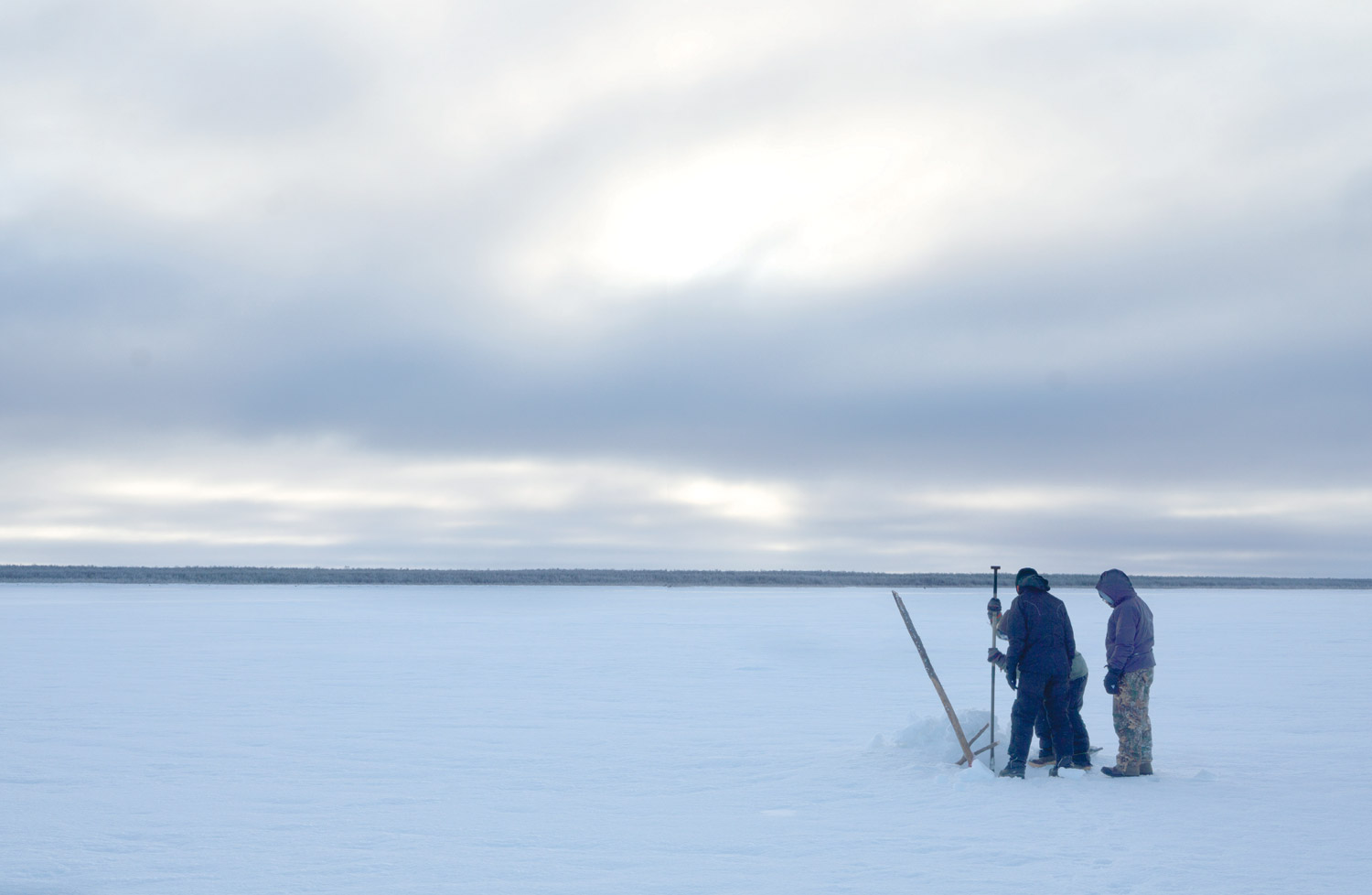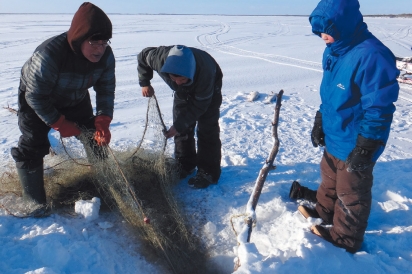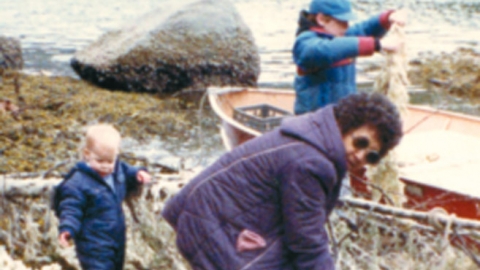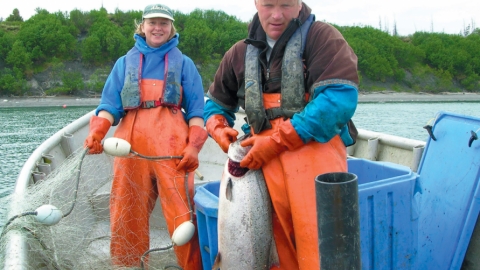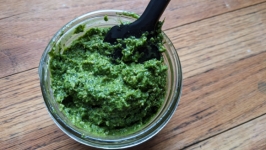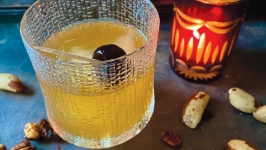Nets Beneath the Ice
Winter Fishing on the Lower Yukon
In summer, the waters of the Yukon River are famous for pulses of king and chum salmon that embark on a 2,000-mile migration from the Bering Sea to Canada. These fish are cherished for their high oil content, size, and generous numbers that fill smokehouses and freezers in communities all along the river.
Fish is so important to the traditional food system that the Yup’ik word for fish, neqpik, is also the Yup’ik word for food. Fortunately, the end of summer does not mean the end of fishing. The Yup’ik men and women of the Yukon enjoy fishing year-round. The change in season signals a switch in species of available fish and in fishing methods. When temperatures drop far enough below freezing, a surface layer of ice forms on rivers and sloughs. People carefully observe the ice and test it for the proper thickness and strength. When conditions are right, it is time to set a net under the ice.
Setting Net
Kuvyatuq is the Yup’ik word for the type of fishing that involves setting a net under the ice. This ingenious method of fishing was developed by the ancestors of the Yup’ik people who continue to live and fish in their traditional homeland today. The net is a mesh made of nylon or other filaments. A weighted rope, called a leadline, holds the bottom of the net in place so that it does not float to the surface. A long ice pick is an essential tool used to chop holes in the ice. People make their own picks by sharpening the end of a metal pipe, or by straightening out a tire iron and welding it onto a pipe.
The first step involves chopping a series of holes into the ice. These holes are lined up perpendicular to the current so that the river will flow through the net and intercept fish as they swim upriver. A long cord is tied to a long wooden pole. One person pushes the pole and the cord through the first hole into the water under the ice. They push the pole until it reaches the next hole where another person grabs it and keeps pushing it towards the next hole. Like a gigantic needle through river and ice, the pole and cord make their way to the last hole where they are hauled up onto the ice. The end of the cord is detached from the pole and attached to the net. At the first hole, a person pulls on the other end of the cord while the person at the last hole feeds the net into the water until it is completely stretched under the ice. On both ends, the top and the bottom of the net are tied to tall 20-foot vertical poles that are then driven into the bottom of the river. The net is set. A covering of ice and snow on the holes insulates them from freezing completely shut. The middle holes are left to freeze over.
“Also, it’s important to make sure that the net doesn’t touch the ice. It has to be a foot or two below the surface of the ice so it doesn’t freeze onto the ice,” explains Dr. Walkie Charles, Yup’ik language Professor at the University of Alaska Fairbanks who grew up ice fishing in Emmonak.
Checking Net
Wind screeches and stings the faces of snowmachiners caravaning down a frozen expanse of ice and snow extending to the horizon. A line of dark willow shrubs and bare cottonwood trees separates the sky from land, marking the shoreline as the group travels toward the mouth of the mighty Yukon River.
The snowmachines grind over a well-traveled trail of ice and snow. Every once in a while, they pass tall wooden poles that tower over the flat landscape. These poles mark the endpoints of nets under the frozen river. They pass by over a dozen poles until they reach the ones that belong to their group.
Throughout the winter season, “checking net” is a regular, sometimes daily journey to the river to see if the nets have caught anything. Mark Tucker, II leads a group of young men from the community and students from Emmonak School to “check net.” Everyone takes turns using a homemade ice pick and shovel to remove any ice that’s built up around the hole.
Tucker, 30, has grown up along the Yukon River. By eighth grade, he was able to go out on the ice on his own to get fish for his family. “I learned by fishing with my father, Mark Tucker,” he says. “He taught me the importance of yuuyaraq, the Yup’ik way of life.” His father was a beloved, long-time Yup’ik teacher at the school who taught many of his students how to fish on the ice until he passed away a number of years ago. Recently, Tucker began to teach the skills he learned from his father to a new generation of future fishers.
The youths take turns using a shovel to scoop floating bits of ice out of the hole. It is common to see people on the lower Yukon using the qenuirun. This traditional techology consists of a thick circular frame attached to a sturdy handle that surrounds a crisscrossing of rope. The mesh holds the ice while letting water pass through, like a sieve.
When ice is clear at the first hole, the youths walk over to the second hole to clear away snow and ice. They detach the end of the net from the pole and attach a long line to the other end of the net. Tucker pulls up the net at the first hole, which drags the line at the other end down into the water and keeps it connected to the pole. The net is long, between 10 and 15 fathoms (60–90 feet).
In the net, they find a gleaming silver-scaled sheefish. This large whitefish is prized especially for making akutaq, a traditional frozen dessert of flaked fish, fat, and berries. The net also caught a glistening, smooth-skinned lush fish, also known as burbot. These big-headed bottom dwellers offer the lucky fisherman a massive creamy liver that is about 10 percent of its body weight and is the north’s richest source of vitamin D. Simple boiling yields succulent tender white meat from the head and body, making the day’s catch a rich winter feast.
While Tucker shares what he knows with the younger generation, he acknowledges that he is still learning. “Last year we set up in the wrong spot. When the ice freezes over, sometimes it breaks apart and smashes together so it gets jagged under the ice. Then it gets caught on the net, and it can tear your net,” he explains. “You have to set the net on a surface area where the ice is really smooth.” Tucker teaches the youths to pay attention to what’s under the ice as well as what it looks like on top, and how to use the ice pick to tell the difference. These skills are essential for being able to fully embrace the rich bounty of food from the land and the water, even in the coldest, darkest days of winter.
Billy Charles is another fisherman in Emmonak who mentors youths by taking them to check net. He emphasizes the importance of learning these essential life skills. “I hear this saying often from our elders: A person who doesn’t work goes idle and stays hungry.”
“Here, there’s food out there for people, but you need to go out and get it. There’s opportunity in spring, summer, all throughout winter, but you need to always be prepared,” Charles notes.
In his lifetime, Tucker has seen the effects of climate change. “It doesn’t seem like it gets that cold anymore,” he observes. “When I was younger, it would get as cold as -30° Fahrenheit in winter. And sometimes the ice would be several feet thick, not just several inches,” he says, holding his arm high over his shoulder. Despite the changes, Tucker continues to share teachings with the younger generation: how to fish, how to respect the land, and how to share these gifts with the community.
One of Tucker’s treasured memories from fishing with his dad is sharing their catch with others. “We would hand out our catch to other people that wanted them. That’s a special thing about the subsistence way of life, sharing to elders and seeing how they are happy to have fresh fish for dinner.” As he got older, his dad would send him to give out fish on his own. “This person wanted some, go give him some,” his father would say. The legacy of the elder Tucker continues on today through his son, his students, and all the Yup’ik sons and daughters for whom the technical skills of fishing and the traditional values of sharing all contribute to living a good life on the lower Yukon River.
After depositing their winter fish into the sleds, the youths haul the line back onto the ice, resetting the net back into the water, ready to be checked again another day.


